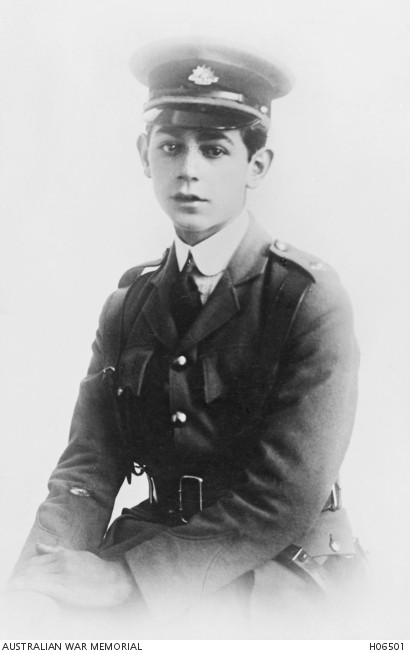
It is nice in the surf, but what about the men in the trenches? Australian War Memorial, ARTV00141
Wartime recruitment posters were unambiguous.
The colourful propaganda, along with newspaper articles and social pressure, played on a sense of guilt and personal honour while promising overseas adventure for would-be recruits.
And they were successful. Not only in attracting young men to enlist, but boys, some barely in their teens.
To help commemorate the centenary of the Great War, The Boys’ Brigade Queensland chose to honour the service of underage soldiers.

The brigade, established over 100 years ago, wanted their own boys to learn more about the teenagers who surrendered their youth and innocence to a foreign conflict.
They Enlisted at My Age project, funded by the Queensland Anzac Centenary Grants Program, allowed brigade members to get to know their wartime equivalents.
Sixteen-year-old James Gilvear lied about his age to join his father and five brothers in the trenches but not before he helped his mother plant bananas on their Glass House Mountains property. The young brigade member who researched James’ life was struck by the contrast between the young soldier’s lush Sunshine Coast farm and the smouldering bleakness of the Western European battlefields.

Studio portrait of 1553 Pte James (Jim) Martin, 1st Reinforcements, 21st Battalion. Australian War Memorial, P00069.001
“… hundreds, maybe thousands, of boys in 1914-1918 volunteered to join the AIF and went to fight in the war at Gallipoli or the Western Front,” according to the project booklet.
“And, like their comrades, many of them died on the battlefield. It will never be known how many or who was the youngest, but they have been identified between 13 and 17 years – under the minimum official enlistment age of 18.
“ … it is appropriate that boys of these ages reflect on the actions of their same-age forebears in Australia in 1914-1918.”
The project was tied to the brigade’s Citizenship Award for the senior boys who were encouraged to get to know young soldiers through letters and other archive material.
Their research, put on public display, included photos of underage soldiers placed alongside brigade members of the same age dressed in military attire.
The comparison is poignant and worthy of reflection.

Portrait of 2251 Pte John A.E. Harris, 2nd Battalion, killed in action 8 August 1915. Australian War Memorial, H06501
The young soldiers adopted different strategies to try and fool recruiters, “some trying many times in different places, even under different names, until they were successful”.
The youngest Queensland boy known to enlist was 14-year-old Leith John McDonald.
Brigade member Dan, who researched Leith’s life, said: “This project has given me insight into World War I. The man I have been studying, Leith McDonald, committed several offences while in the army, including stealing and being AWOL. This has helped me gain a rawer view of Anzac Day and war.”
Project coordinator, Don Smith said: “The project was conducted in 2015 (the centenary of the Gallipoli landing), but has developed an on-going momentum, which is expected to run for the duration of the recognition of the centenary of the First World War and will he highlighted as other battles are recognised 100 years on – particularly when an underage soldier from the project fought and possibly was killed in that battle.”
Dianne McKean
Comments
Your email address will not be published.
We welcome relevant, respectful comments.